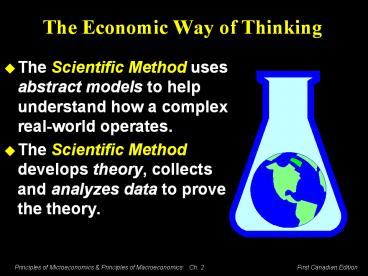The Economic Way of Thinking - PowerPoint PPT Presentation
1 / 18
Title:
The Economic Way of Thinking
Description:
Title: Thinking Like an Economist Author: Steve McGary Keywords: scientific method, circular flow, micro, macro Last modified by: Doug Smith Created Date – PowerPoint PPT presentation
Number of Views:82
Avg rating:3.0/5.0
Title: The Economic Way of Thinking
1
The Economic Way of Thinking
- The Scientific Method uses abstract models to
help understand how a complex real-world
operates. - The Scientific Method develops theory, collects
and analyzes data to prove the theory.
2
The Circular-Flow Model
- Provides a simple way of describing all the
economic transactions that occur in a Market
Economy. - Emphasizes decentralization in that economic
decisions are made by Households and Businesses
in Product and Resource Markets.
3
Diagram The Circular-Flow Model
Product Markets
Dollar Flow Real Flow
Businesses
Households
Resource Markets
4
Microeconomics and Macroeconomics
- Microeconomics focuses on the individual parts
of the economy. - e.g. individual markets
- e.g. price increase in the house market
- Macroeconomics looks at the economy as a whole.
- e.g. aggregate of markets
- e.g. average price increase for all goods
5
A Second Economic Model Production
Possibilities Frontier.
- is a graph that shows the various combinations
of output that the economy can possibly produce
given the available factors of production and
technology.
6
Production Possibilities Frontier
E
3000
A
2000
Computers
F
Cars
1000
700
0
7
Production Possibilities Frontier
E
3000
A
2000
Computers
F
Cars
1000
700
0
8
Principles of Economics Illustrated by the
Production Possibilities Frontier . . .
- Efficiency
- Tradeoffs
- Opportunity Cost
- Economic Growth
9
Production Possibilities Frontier
E
Efficient Resource Use
3000
A
2000
B?
1000
Computers
F
Cars
1000
700
0
300
10
Production Possibilities Frontier
E
Tradeoffs
3000
A
2000
C
1000
Computers
F
Cars
1000
700
0
900
11
Production Possibilities Frontier
Opportunity Cost of next 200 cars is 1000
computers. Opportunity cost of 1 car is 5
computers
E
3000
2000
A
Opportunity Cost
C
1000
Computers
F
Cars
1000
700
0
900
12
Production Possibilities Frontier
Economic Growth
3000
2000
1000
Computers
Cars
1000
700
0
300
13
Positive versus Normative Analysis
- Positive Statements or assertions dealing with
matters of fact or questions about how things are
(descriptive analysis). - Normative Statements that reflect individual
opinions (prescriptive analysis).
14
Positive or Normative Statements?
- An increase in the minimum wage will cause a
decrease in employment among the least skilled. - Higher federal budget deficits will cause
interest rates to increase. - The income gains from a higher minimum wage are
worth more than any slight reduction in
employment. - Provincial governments should be allowed to
collect from tobacco companies the costs of
treating smoking-related illnesses among the poor.
15
Economists in Government . . .
- Department of Finance - formulate tax policy.
- Industry Canada - design competition policy.
- Foreign Affairs - assist with trade agreements.
- Human Resources Development Canada - formulate
labour market policies. - Bank of Canada - implement monetary policy.
- Environment Canada - design environmental policy.
16
Economists in the Private Sector . . .
- C.D. Howe Institute - suggest policy options.
- Fraser Institute - suggest policy options.
- Provide forecasts for companies.
- Assist firms manage resources efficiently.
- Assist with investment decisions.
17
Do Economists Always Agree With Each Other?
Three reasons why they dont
- Disagree about the validity of alternative
positive theories - Each have different values, thus different
normative views - Advice of charlatans or cranks complicates
ability to agree
18
Thinking Like an Economist . . .
- Economics uses the scientific approach.
- Economics is divided into Microeconomics and
Macroeconomics. - Economics is analyzed through both Positive and
Normative statements.































